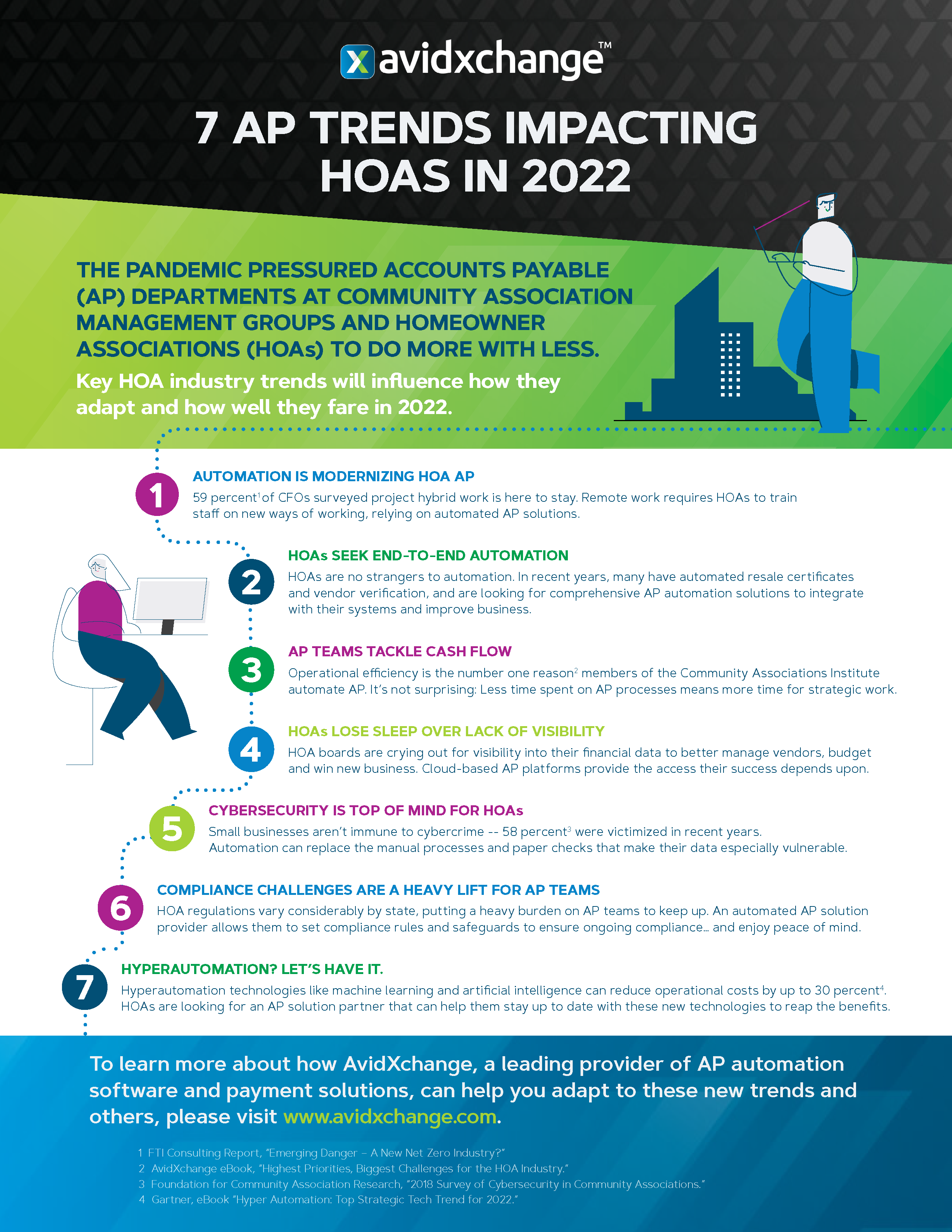The pandemic has added new pressure on accounts payable (AP) departments at community association management groups and homeowner associations (HOAs). A shift to virtual work, burgeoning workloads, shrinking staffs and demand for tighter cash flow management are just a few of the challenges they continue to face. They lead to a single directive — do more with less.
How are community association management companies (CAMs) faring as they evolve with their industry and move into 2022? Here we explore key HOA industry trends that are helping to define priorities and progress:

CLICK HERE TO DOWNLOAD THE INFOGRAPHIC
This handy guide outlines the five trends expected to impact the way community management associations manage their invoices and payments in 2022 and beyond.
1. HOA AP staffs face opportunities for change
Community association management benefits from its experienced workforce, yet hesitation from staff to do things differently can challenge modernization.
Despite the fear of change, replacing manual tasks with technology-driven tools has become mission critical for CAMs. It makes remote work possible, eases financial and time burdens and provides visibility. It also offers a competitive edge, something no CAM can afford to do without in 2022.
As this group reaches retirement, it’s leaving gaps to fill. While a competitive job market makes it tough to secure talent, there’s opportunity for AP departments to attract new hires by offering technology that promises to make their work more efficient and fulfilling. It’s expected that many new hires will bring experience and technology know-how from previous jobs, helping to modernize AP operations.
“Since the early days of the pandemic when access to offices was restricted, HOAs have been working to train staff to access financial data and manage critical invoice and payment processes remotely. The move requires the adoption of technology, something older workers may be slow to embrace. Their hesitance puts a strain on AP departments, adding to the challenges already on their plates.”
Erin Rapp, Senior Account Executive (HOA), AvidXchange
2. Increased adoption of end-to-end automation
Despite some AP staff’s reluctance to change the way they handle their invoice and payment processes, HOAs are no strangers to automation. In recent years, many have automated resale certificates and vendor verification, for instance, and are looking for other automation solutions to integrate with their systems and improve business.
For property managers dealing with multiple properties, approvers and invoices, an end-to-end automated AP process is an invaluable next step in their automation investment.
“With each new year, the HOA industry gets more tech savvy, understanding that automation can enable them to double in size without adding additional staff,” said Rapp.
Comprehensive automation solutions — covering invoice to payment — can create more efficient processes, save time and money, eliminate the need for additional headcount, and free time for more strategic work.
It’s expected that as firms realize the host of benefits and look for competitive advantage, they’ll continue to move toward complete automation solutions.
3. Strong push for greater efficiency, strategic focus
CAM teams have a lot on their minds. In addition to keeping up with customer, vendor and board member demands, they’re pressured to more carefully manage their cash flow.
They get that these demands require them to create operational efficiencies, such as streamlining cumbersome tasks like securing necessary approvals on invoices and paying bills. Automation can help. In fact, 78 percent of those surveyed in an AvidXchange survey of nearly 500 members of the Community Associations Institute (CAI) said the creation of operational efficiency was the primary reason for automating their AP.
They also need their people to focus on higher level, strategic decision making like whether to move forward with capital improvement projects and how best to cut expenses. By eliminating paperwork, they’ll gain more time, freeing them for strategic work. They’ll also have more time for meeting with boards and visiting properties, which will ultimately help to grow their business.
As CAM AP teams continue to advance their automation investments, we’ll likely see team members take on broader initiatives, spend more time on vendor research, and begin to do more work with other departments within their organizations.
4. Leveraging data to power visibility, impactful marketing
Lack of visibility into financial data is a source of heartburn for the boards of HOAs. It’s often tough for them to access the info they need when it’s scattered across systems and locations.
“Automated AP solutions store pertinent, historical data in one easy to access location, and allows users to be approvers or read-only users, so everyone who needs to see payables and invoices can get to the information they need,” said Rapp. “Among the many benefits to the visibility is the fact that it provides a fantastic marketing tool for management companies bidding new projects.”
Greater visibility provides a host of other benefits, including the ability to easily view what’s been paid in previous months, where there have been bottlenecks in payments (that result in late fees), and where there’s opportunity to negotiate or replace a vendor.
What’s more, HOA boards love the transparency and controls automation provides. Nothing will get paid unless it’s going through the proper approvals, which reduces the possibility of fraud and provides peace of mind.
In the coming year, it’s likely that HOAs will pay closer attention to their data to better manage vendors and budgets, and continue looking to automation for access.
5. Growing importance of cybersecurity
While no company is immune from the threat of fraud, those that depend on manual processes are especially vulnerable. Breaches can have serious consequences, impacting a management company’s financial stability and damaging reputation and relationships.
In the new year, HOAs will likely look to their automated AP solutions to help ward off cybercrime like phishing attacks and check fraud. When they adopt an automated payment system, they transfer risk to the automation provider — who has expertise and strong security measures in place — reducing the risk of criminals accessing sensitive information and also reducing the risk of check fraud.
Automation also benefits HOAs by offering secure electronic payments and providing financial safeguards that prevent security breaches and criminal activity at the managed properties.
In 2022, it’s likely that cybersecurity will be a driving force for automation.
6. Ongoing compliance challenges
HOA regulations vary considerably state by state. Some states have rigid requirements and others feel like the Wild West.
Keeping up with changing compliance requirements falls on AP departments. It’s a complex and time-consuming responsibility, especially for firms like HOAs that deal with multiple vendors and sometimes work across state lines.
More and more, companies are looking for a simpler way to manage the tasks without compromising their compliance.
“You don’t have to stay up to speed on every evolving regulation when you rely on an automated AP solution provider,” said Rapp. “Instead, you can set up compliance rules and safeguards and forget about it. Automation helps provide total peace of mind.”
In 2022, it’s expected that more firms will invest in technology to streamline the work, provide better visibility into the invoice approval process, and reduce the need for human interaction which can often lead to error or oversight.
7. Expanded awareness of hyperautomation
Community management associates are increasingly curious about hyperautomation. It’s for good reason. Gartner estimates the next level hyperautomation technologies like machine learning and artificial intelligence can reduce operational costs by 30 percent, saving organizations across industries both money and time.
“I’m asked more about hyperautomation every year, as people become more familiar with what technology is out there and wonder what it can do for their work and their businesses,” said Rapp. “It won’t be long before it’s a regular part of AP.”
The challenge with the use of hyperautomation by HOAs is that their invoices can vary by type and vendor. Sometimes they aren’t in a format that OCR or AI can easily read. Therefore, they require some human element in the process. As the technologies advance, fit and adoption within community organizations is likely to improve, and AP teams want to have a partner that is ready to scale with them as innovation evolves.



